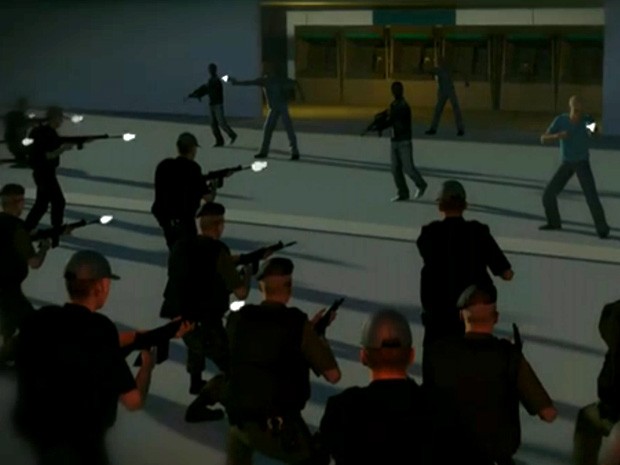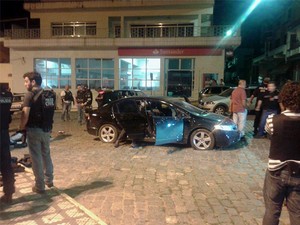Morador captou da janela de casa o áudio dos disparos durante ação.
Nove pessoas morreram e cinco ficaram feridas em tiroteio.
Um vídeo feito pelo celular de um morador de Itamonte (MG) mostra o momento em que policiais e integrantes de uma quadrilha trocaram tiros durante uma tentativa frustrada de assalto a uma agência do Banco Bradesco, na madrugada deste sábado (22). Pelo menos nove criminosos foram mortos e cinco pessoas ficaram feridas, entre elas, três policiais civis.
Pelo áudio das imagens é possível perceber quando os disparos são feitos. Por volta das 2h os criminosos explodiram caixas eletrônicos do Banco Bradesco e, durante a ação, foram cercados pelos policiais, que já tinham informações sobre a possibilidade do assalto. A quadrilha já era investigada havia pelo menos três meses e pretendiam assaltar pelo menos três agências bancárias da cidade.
Pelo áudio das imagens é possível perceber quando os disparos são feitos. Por volta das 2h os criminosos explodiram caixas eletrônicos do Banco Bradesco e, durante a ação, foram cercados pelos policiais, que já tinham informações sobre a possibilidade do assalto. A quadrilha já era investigada havia pelo menos três meses e pretendiam assaltar pelo menos três agências bancárias da cidade.
Enquanto uma parte do grupo explodiu a outra agência, os outros integrantes ficaram em uma praça onde têm dois bancos, só que antes de detonar a dinamite, eles foram surpreendidos pela polícia. Os assaltantes estavam divididos em sete carros e, de acordo com a assessoria do governo do estado, eles pretendiam também dominar o pelotão da Polícia Militar de Itamonte e atacar ainda caixas eletrônicos em Itanhandu (MG). Durante a ação em Itamonte, foram apreendidos fuzis, espingardas calibre 12, pistolas, dinamites, munições e coletes à prova de bala. A informação da polícia é de que a quadrilha seja formada por pelo menos 20 pessoas. Quatro delas foram presos.
Um homem de 26 anos foi preso pela Polícia Civil de Mogi das Cruzes (SP) em um condomínio de luxo na cidade de Arujá (SP). Com ele, foram apreendidos uma moto, veículos e dinheiro manchado com tinta vermelha, proveniente do sistema de segurança dos caixas eletrônicos. Outro homem suspeito de integrar a quadrilha foi preso em Pindamonhangaba (SP).
saiba mais
Entre os suspeitos mortos, oito eram de Mogi das Cruzes (SP) e um era de Itanhandu (MG). Três policiais civis foram atingidos por disparos feitos por fuzis. Eles foram socorridos em um helicóptero e levados para São Paulo (SP). Dois criminosos também ficaram feridos, foram internados e após receberem alta, foram levados para o Presídio de Pouso Alegre (MG). Já os corpos foram levados para os IML de São Lourenço (MG), Pouso Alegre (MG) e Itajubá(MG).
Cerca de 200 policiais civis e militares de Minas Gerais e de São Paulo participaram da ação. A Polícia Rodoviária Federal também apoiou a operação. Embora os policiais tenham cercado a cidade, alguns criminosos conseguiram fugir e, apesar das buscas feitas com helicópteros da Polícia Militar em matas próximas, não foram encontrados.
Cerca de 200 policiais civis e militares de Minas Gerais e de São Paulo participaram da ação. A Polícia Rodoviária Federal também apoiou a operação. Embora os policiais tenham cercado a cidade, alguns criminosos conseguiram fugir e, apesar das buscas feitas com helicópteros da Polícia Militar em matas próximas, não foram encontrados.
Já a população da cidade, com cerca de 15 mil habitantes e apenas uma rua principal, está assustada com o caso. “Eu achei que o mundo estava acabando. Era só tiro, tiro, bombas. Nunca vi isso aqui. Estou assustada, muito nervosa e apreensiva”, disse a enfermeira Márcia Aparecida Leite.
De acordo com o capitão da Polícia Militar, Marcelo Duarte Borges, a quadrilha é suspeita de ter realizado 14 assaltos no interior de São Paulo e nove no Sul de Minas durante o último ano. “Por ser uma região fronteiriça, isso favorece as rotas de fuga pelo Vale do Paraíba e também pela Via Dutra e eles vão para São Paulo ou para o Rio de Janeiro”, explicou.
No final da tarde deste sábado, funcionários do banco foram enviados ao local e começaram a realizar os reparos onde houve a explosão. Com este caso, foram registradas oito ocorrências de ataques a caixas eletrônicos neste ano no Sul de Minas. Em 2013, o número foi de 77 casos na região.
De acordo com o capitão da Polícia Militar, Marcelo Duarte Borges, a quadrilha é suspeita de ter realizado 14 assaltos no interior de São Paulo e nove no Sul de Minas durante o último ano. “Por ser uma região fronteiriça, isso favorece as rotas de fuga pelo Vale do Paraíba e também pela Via Dutra e eles vão para São Paulo ou para o Rio de Janeiro”, explicou.
No final da tarde deste sábado, funcionários do banco foram enviados ao local e começaram a realizar os reparos onde houve a explosão. Com este caso, foram registradas oito ocorrências de ataques a caixas eletrônicos neste ano no Sul de Minas. Em 2013, o número foi de 77 casos na região.
fonte:http://g1.globo.com/




















